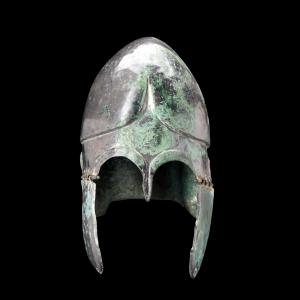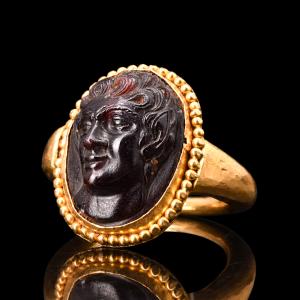London’s Apollo Art Auctions to host July 23 sale of expertly curated ancient art, antiquities, coins and jewelry

Egyptian face from wooden coffin lid, 26th Dynasty, circa 664-525 BC. Size: 410mm x 390mm (16.1in x 15.4in). Estimate £6,000-£9,000 ($7,700-$11,550)

Greek Chalcidian hammered bronze helmet, circa 500-300 BC, contoured double curve above brow; hinged, articulated cheek guards. Estimate £15,000-£20,000 ($19,380-$25,840)

Ancient Roman amethyst cameo ring with a finely rendered portrayal of a satyr. Circa 4th-6th century AD.. Estimate £6,000-£9,000 ($7,700-$11,550)
Featured: Egyptian mummy mask from Late Ptolemaic period, Hellenistic gilt silver bowl, Babylonian cuneiform tablet, Gandharan panel with Buddha & Bodhisattvas
Many forms of historical heavy metal will weigh in, starting with an incredible Greek Chalcidian hammered bronze helmet dating to circa 500-300 BC. Its unusual design incorporates a contoured double curve above the brow, and hinged, articulated cheek guards. By the time of the Peloponnesian War (434-402 BC), the Chalcidian helmet was the most widely distributed head protection seen in Greek military ranks. The auction example exhibits beautiful natural verdigris that only enhances its presentation. Coming from a London private collection, it could pass to its next owner for a winning bid in the range of £15,000-£20,000 ($19,380-$25,840).
Another highlight from the broad selection of ancient weaponry is a circa-1100 AD Norman iron sword – classified as an Oakeshott Type A with a blade that is most probably an Oakeshott Category XI – whose design includes a distinctive “Brazil nut” pommel. The hilt is short, a feature copied by Norman swordsmiths from their Viking and Saxon predecessors. Formerly the property of a European collector and before that, part of a German collection, it comes to auction with an estimate of £2,500-£4,500 ($3,230-$5,815)
Metal of a very different kind is seen in a Hellenistic gilt silver bowl dating to the 3rd-2nd century BC. Greek inspired and probably from the Seleucid Empire (western Asia), it is stunningly gilt-decorated and chased with a floral and botanical motif. The vessel was XRF tested at Oxford Labs and examined at the Striptwist Ltd., laboratory in London. Its provenance includes a Central London gallery and prior sales via the US and UK art markets. Accompanied by a French export document, it carries a £12,000-£20,000 ($15,500-$25,840) estimate.
Many jewelry collectors have discovered the glorious designs of Roman goldsmiths through Apollo Art Auctions’ sales. One of the company’s finest selections of Roman and other ancient jewelry will be offered at their July 23 event. Highlight include: a Hellenistic solid gold ring with a nude Aphrodite, a gold ring with a childbirth scene incised on a carnelian stone, and a sensational amethyst cameo ring with a finely-rendered bas-relief portrait of a satyr. Created circa 4th-6th century AD, the latter ring was previously part of a UK private collection and, before that, an old Swiss family collection formed in the 1990s. Its estimate is £6,000-£9,000 ($7,700-$11,550).
A very special entry is a circa 100-300 AD Eastern Roman gold pin with very fine filigree and scrollwork, a figure of the winged Eros perched atop a finial, and an attached chain. Originally, it might have been used to secure a shawl or tunic, or to adorn a woman’s hair. The pre-sale estimate for this unusually fine example of Roman artistry is expected to make £6,000-£9,000 ($7,700-$11,550).
Pre-dating Imperial Rome and its art traditions by several centuries, an Apulian red-figure column krater, circa 400-300 BC, was crafted from black-glazed pottery and adorned on both sides with meticulously-detailed portraits of the “Lady of Fashion.” Additionally, there are multiple registers of repeated geometric motifs. The auction example is comparable to a krater that sold at Christie’s on July 5, 2017, and is estimated at £6,000-£9,000 ($7,700-$11,550).
More than five dozen numismatic lots are entered in the auction, including several known as “solidus” coins – a name that refers to the fact that they are made of solid gold. A rare 332-333 AD solidus from the city of Thessalonica (Macedon, northern Greece) bears the image of Constantine II as Caesar AV on both sides. The co-emperor of Greece and son of Constantine the Great is shown facing right on the coin’s obverse and standing to the left, in military attire with a vexillum and long scepter, on the reverse. An exemplary addition to any ancient coin collection, it is estimated at £6,000-£9,000 ($7,700-$11,550).
A rare surviving relic from the days of Old Babylonia, a circa 1900-1600 BC cuneiform ceramic tablet in rectangular form is written in a very rare language: Hurrian. The Hurrian people first inhabited the Ancient Near East during the Early Bronze Age, and their language was spoken throughout northern Syria, upper Mesopotamia and southeastern Anatolia. This extraordinary antiquity from the First Babylonian Empire measures 160mm by 50mm (6.3in by 2in) and is estimated at £6,000-£9,000 ($7,700-$11,550).
An extraordinarily well-preserved Egyptian face from a wooden coffin lid dates to the 26th Dynasty, circa 664-525 BC. The striking yellow-blue tripartite wig serves as not only a handsome adornment but also a symbol of the individual’s desire for eternal youth and vitality. The nose and lips were crafted with great attention to detail, and the sclera of the eyes were enhanced with a clear white pigment, lending a lifelike quality to the mask. Overall, there is a sense of serenity to the visage. The auction estimate is £6,000-£9,000 ($7,700-$11,550).
One of the sale’s premier Asian artworks is a Gandharan schist relief panel that depicts a seated Buddha Shakyamuni being reverently attended by Brahma, Indra, and two Bodhisattvas. The Buddha’s features are expertly sculpted, with almond-shaped eyes that convey a profound sense of compassion and wisdom – qualities the religious teacher and founder of Buddhism possessed from having attained enlightenment. This sizable work weighs 78.35kg (173lbs) and is similar to one that sold on Sept. 23, 2020 for record-setting $6.6 million at Christie’s. Estimate: £10,000-£15,000 ($12,840-$19,260)
The July 23, 2023 online-only auction will commence at 7 a.m. US Eastern Time/12 p.m. BST. View the fully illustrated auction catalogue and sign up to bid absentee or live online through LiveAuctioneers. Apollo Art Auctions accepts payments in GBP, USD and EUR; and ships worldwide. All packing is handled by white-glove specialists in-house. No import charges apply to most antiquities entering the USA. For questions about any item in the sale or to discuss consigning to a future Apollo auction, please call the London gallery on +44 7424 994167 or email info@apollogalleries.com. Online: www.apolloauctions.com
Rate of exchange as of date of publication: £1 = approximately US$1.29
Dr. Ivan Bonchev
Apollo Art Auctions
+44 7424 994167
info@apollogalleries.com
Visit us on social media:
Facebook
LinkedIn
Instagram
Other
Legal Disclaimer:
EIN Presswire provides this news content "as is" without warranty of any kind. We do not accept any responsibility or liability for the accuracy, content, images, videos, licenses, completeness, legality, or reliability of the information contained in this article. If you have any complaints or copyright issues related to this article, kindly contact the author above.


